Fluctuations of Bovine Milk Chemical Composition in Cows Fed on Legume Stover and Feed Grade Urea Fertilizer Nitrogen-Based Feeds
Chisowa DM1* and M PofuI DT2
1Southern University, School of Agriculture, Department of Animal Science, Zambia
2Chinhoyi University of Technology, School of Agricultural Sciences and Technology, Department of Animal Production and Technology, Zimbabwe
Submission: November 7,2020;Published: December 08, 2020
*Corresponding author: Chisowa DM, Southern University, School of Agriculture, Department of Animal Science, P. O Box 60293, Livingstone, Zambia
How to cite this article: Chisowa D, M PofuI D. Fluctuations of Bovine Milk Chemical Composition in Cows Fed on Legume Stover and Feed Grade Urea Fertilizer Nitrogen-Based Feeds. JOJ Wildl Biodivers. 2020: 3(2): 555608 DOI: 10.19080/JOJWB.2020.03.555608
Abstract
This study evaluated the weekly fluctuations of bovine milk quality from cows fed Legume Stover (LS) and feed grade urea fertilizer (UET). The study involved feeding Maize Stover (MS) improved using UET, Chopped Groundnut Stover (CGS), Chopped Soybean Stover (CSS), Mineralized Groundnut Stover Solution (MGS) and Mineralized Soybean Stover Solution (MSS) to lactating dairy cows. The feeding trial involved twelve (12) dairy cows in their second parity. Effect of supplementation with MS improved with UET, cGS, cSS, mGS and mSS on milk quality was evaluated following on-station feeding trials. The study involved 22 factorial experiments within a Completely Randomised Design (CRD). Milk samples were analysed for protein, lactose, fat and solid not fat (SNF) and milk density.
Mean milk protein levels ranged from 3.52mg/ml to 3,73mg/ml (s.e=0.03) for milk from cows fed on MS improved using cGS and mGS respectively. Protein and Lactose were observed to be the least variable (3.64g/ml ±0.12, and 5.24g ±0.24 respectively). Average milk fat content was highest (4.78%, se=0.52) in milk from cows fed on UET treated MS and lowest (3.43%, se=0.52) in milk from cows fed on gGS protein-based MS. Within legume type milk fat was higher (4.75%±1.99) in milk from cows fed on MS blended with mGS than that in milk from cows fed on MS improved with cGS (3.43%±1.99). Similar result was observed in milk fat from cows fed on MS improved with the use of soybean. Lactose in milk from cows fed on UET treated MS was highest (5.51g, se=0.061) and lowest (5.10g, se=0.061) in milk from cows fed on MS blended with cGS. Milk from cows fed on MS improved with mGS was higher (9.61p/cwt, se=0.14) in SNF and lowest (8.88p/cwt, se=0.14) in milk from cows fed on MS with cGS. The milk density values ranged from 32.65sg, se=0.53 for milk from cows fed on UET treated MS to 30.42sg, se=0.053 for milk from cows fed on MS blended with cGS. Milk components were higher when cows were fed on MS improved using mineralized legume stover solutions. Results of the current study have indicated that milk composition is clearly influenced by diet, and period of lactation. In the current study it was observed that milk fat was the most variable component not only among feed types but also over the feeding period.
Keywords: Fluctuation; Milk quality; Mineralized; Chopped; Maize; Groundnut; Soybean; Stover
Introduction
The nutritional value of livestock products has been acknowledged in human nutrition. For example, [1] stated the following with regard to the use of animal products in human diet: “As diet becomes richer and more diverse, the high-value protein that the livestock sector offers improves the nutrition of the vast majority of the world. Livestock products not only provide high-value protein but are also important sources of a wide range of essential micronutrients such as iron and zinc, and vitamins such as vitamin A. For the large majority of people in the world, particularly in developing countries, livestock remains a desired food for nutritional value and taste.” This statement is particularly true for Zambia where the per capita consumption of meat is only 2.4 kg per annum [2]. In the advent of the HIV/AIDS pandemic, livestock has even become critical in that animal products provide specific nutrients that directly demobilize the progression of HIV to the AIDS condition. This is because these nutrients are associated with maintenance or enhancement of the immune system of the human body. Meat is a good source of high-quality protein, micronutrients such as zinc, magnesium, selenium, iron and vitamins A, E, and B-complex [3,4]. Work by [4], revealed that milk is the most complete of all foods, containing all the constituents of nutritional importance to human beings.
Eggs make a useful contribution to the daily intake of vitamin D, retinal, riboflavin, iodine, iron and protein. Thus, a combination of red meat, eggs and milk provides a complete diet to take care of all the necessary nutrients that would mitigate or keep the HIV at low levels and keeping a person healthy. Clearly, the importance of livestock from a nutritional point of view and the well-being of human beings cannot be overemphasized.
Many factors can influence milk composition. This is an important point to remember when evaluating the potential to improve a herd’s milk composition and component yields. The major components of milk are water, fat, protein, lactose and minerals. Factors that influence composition are genetics and environment, level of milk production, stage of lactation, disease (mastitis), season and age of the cow. Farms that used genetic information (EBV) and phenotypes when selecting sires were higher (p<0.05) for milk fat percentage than farms that used only phenotypes and personal opinion [5,6]. reported that, with increase in feeding of concentrate, there is also a reciprocating increase in milk protein components up to a point where if dry matter in the diet is more than 50% concentrate, the increase in starches shows a decrease in milk fat percentage. Feeding strategies that optimize rumen function also maximize milk production and milk component percentages and yield [7]. Dairy breeds mostly used by dairy farmers show variations in fat, protein, lactose and ash. This shows the influence of breed on milk quality [8]. Work by [9], indicated that the composition of milk varied for some components. There was seasonal variation (p<0.05) on calcium. Total solids (TS) and soluble nitrogen fats (SNF) were significant (p<0.05) as affected by season. Parity and season had no effect on cholesterol, magnesium and phosphorus. A study by [10], indicated that parity, year of calving, days in milk and age of calving affect yield and composition of milk of Red Dane cows in Zimbabwe. It was reported by [11], that milk protein and SNF were found to be higher during rainy season than in the summer and winter seasons. Proper feeding significantly increased milk yield and to a certain extent, could alleviate the decline in milk components. Air temperature above 25oC and humidity below 65% has effect on changes in milk fat, protein and lactose content. Milk yield, protein and lactose content are affected by the kind of supplemented green feed [12]. Feed quality and quantity have been observed to show seasonal fluctuation, a trend which affects animal nutrition and performance. Dry seasons in Zambia and many other tropical countries are marked with periods of feed shortages resulting in general retardation in animal growth and production [13]. A systematic critical appraisal of the establishment and management methods of improved pasture and fodder species is probably relevant in the promotion of better development and utilization of the crop by dairy cattle in the small-scale farming systems [13]. Milk composition is influenced by season, storage conditions, lactation period and regional location. This is due to changes in temperature and feed availability during different seasons. Development of different feeding systems according to season and region is needed to produce high quality and satiable milk production [14,15] observed that milking period affects milk fat, making the fat percentage lower in the morning compared with the evening milking period. Seasonal differences in milk fat, protein and somatic cell count were significant.
It is against this background that a research project was carried out at the Batoka Livestock Research Centre in Choma district of the southern province of Zambia with an objective of assessing the effect of inclusion of legume stover on milk quality and nutritive value. The study specifically compared the nutritional composition of milk from cows fed on groundnut and soybean nitrogen based maize stover as well as the effect of stover processing methods on milk quality.
Material and Methods
Research site
The research was conducted in Southern Province of Zambia. The province lies at an altitude range of 400- 1400 m above sea level. It has a mean annual temperature ranging from 14°C to 28°C. It receives an annual rainfall of 700 mm to 1000 mm. The soil type ranges from clay to sandy loam [16].
Methodology
Study
Treatment with urea
Dry maize stover was chopped using a stover shredder and treated using the Urea-Ensiling Technique (UET) before being offered to the cows. The standard method of urea treatment used in other developing countries which involves the making of a solution of urea using four (4) kg urea fertilizer feed grade (46%N) into sixty (60) litres of water and mixing this with one hundred (100) kg of stover was used. Pits were dug on raised ground for the purpose of the UET. The stover was chopped into 3-5 cm pieces, mixed with the urea solution using a watering can and buried into the pit, ensuring an air-tight environment using polythene plastic sheets and compacting. The stover and straw were ready for feeding in 21 days (3 weeks urea incubation period). Three kilograms (3 kg) of the feed was given to each cow per day in a 22-factorial experiment in a Complete Randomised Design (CRD). UET was taken as novel therapy or positive control and compared with the test therapies.
Study
Treatment with legume stover
The quality of maize stover was improved using mineralized and chopped legume stover [Groundnuts (Arachis hypogea) and Soybean (Glycine max)]. These feeds constituted test therapies. The feed ingredients (maize and legume stover) were all procured from local farmers. Three kilograms (3 kg) of the feed was given to each cow per day in a 22-factorial experiment in a Complete Randomised Design (CRD). Four rations were prepared on the basis of cereal type, legume type, source of nitrogen and method of processing of legumes as follows:
a. Maize stover + mineralized Groundnut stover solution
b. Maize stover + chopped Groundnut stover
c. Maize stover + mineralized Soybean stover solution
d. Maize stover + chopped Soybean stover
A similar number of animals fed on a commercial diet (dairy meal) were used as a positive control. Additionally, another similar number of animals that just grazed normally (no supplementation) were used as a negative control. Test diets were formulated such that they were iso – nitrogenous (same CP) and iso – energetic (same GE or ME). To ensure that the diets were iso-nitrogenous and iso-energetic, samples of cereal stover and legume stover were analysed for their GE and nitrogen content respectively before rations were compounded. Quantities of cereal and legumes (maize, groundnut and soybean stover) used were computed by simple proportion to equate the energy and nitrogen content in each feed based on the results of the proximate analysis. This was important for the data to be valid and reliable hence the conclusions and recommendations.
Mineralization of legume stover
Dry groundnut and soybean stover were tied into bundles each weighing 5 kg. Three (3) bundles of groundnut stover were completely immersed in 100 litres of water in a plastic drum of 210 litre capacity. The drum was covered with a tight lid. Another three (3) bundles of soybean stover were treated in a similar manner in another drum. The set up was left for five days to allow for mineralization to take place. A preliminary proximate analysis of samples revealed that a period of five (5) days was the optimum for mineralization to be effective.
Ration formulation
Rations were prepared using the BLP 88 computer program [17,18] to meet the nutrient requirements of dairy animals (NRC, 2001) [18]. Amounts generated from the ration formulation program were measured using a scale. These were mixed by rolling and turning several times on polythene plastics spread on concrete floor using a garden fork in order to ensure consistence in the composition.
Two (2) types of rations were compounded: one comprising chopped cereal and legume stover. The other comprised chopped cereal stover and mineralized legume stover solutions. The mineralized legume stover solutions were sprayed on the measured quantities of chopped maize stover using a watering can and then turned several times using a garden fork on a concrete floor. To help bind the chopped (ground) legume stover to maize stover, as well as to improve palatability, molasses solution was sprinkled and mixed with all types of ingredients at compounding. All other ingredients were the same for the rations but only differed in the source of protein and processing method used. Feeds were then packed in 25 kg plastic bags in readiness for delivery to the feeding or milking parlor site where feeding was carried out.
Feeding trials
The feeding trials involved twelve (12) lactating dairy cows in their second parity arranged in a 22-factorial experiment within a Complete Randomized Design (CRD). The experimental units (dairy cows) were randomly selected using simple random numbers from the herd available at Batoka Livestock Trust Research Centre (BLTRC). Treatments (rations) were randomly allocated to experimental units (dairy cows) by picking lots using animal identities (Ear-tags and feed type) written on pieces of paper and placed in two separate urns (boxes). An adaptation period of five (5) days was allowed for each feed before data was recorded.
The feeding trial commenced by determining the optimum quantity of feed to be given to each animal. Quantities of fourkilogram (4 kg), three kilograms (3 kg), two kilograms (2 kg) and one-kilogram (1 kg) were tried over a period of seven (7) days. During the trial one kilogram (1 kg) of feed was found to be the appropriate quantity of feeding to appetite during supplementation since rejected quantities were much less. The experimental cows were allowed to graze from seven (7) to twelve (12) hours and then brought to the milking parlor for milking each day. Each animal was offered one (1 kg) of the rations being administered at a given time (control or test therapy). The control or test treatments were supplements to the free grazing during times of feed shortage. The parameters used to test the effect of the treatments was feed intake. An adaptation period of seven (7) days was allowed for each feed before data was recorded. Data pertaining to feed intake was taken as the difference between feed offered and feed left in the feeding trough. Data was for each experimental unit were recorded on score sheets.
Statistical model
Yij=μ +Ri + Wj + (RW)ij + b(x) + εi
Where Yij= observed milk quality on individual cow of a given ith legume type and jth week.
μ=overall mean
Ri=effect of the ith legume type
Wj=effect of jth week
(RW)ij = effect of two-way interaction of ration and week
b(x)=b is the regression coefficient for initial milk quality used as a covariate
εij=random error component
Research design and data collection
The twelve (12) dairy cows were arranged in a 22-factorial experiment in a Complete Randomized Design (CRD). Daily feed intake was recorded on individual score cards identified by animal identity numbers from June 12, 2017 through November 09, 2017.
Statistical analysis
Data was analysed using the Statistical Analysis System on the General Linear Model computer. Treatment means were compared using the F-test.
Results
Milk quality analysis
Protein content
Mean milk protein levels ranged from 3.52 mg/ml to 3,73 mg/ml (s.e=0.03) for milk from cows fed on maize stover whose quality was improved using chopped groundnut stover and that from milk for cows fed on maize stover whose quality was improved using solution from mineralized groundnut stover respectively. However, though the means differed numerically the differences were not significant (p>0.05). Results presented in (Table 1) (Figure 1) show a general increase in protein level with a period of lactation within each feed type. Mean milk protein levels increased gradually from week 1 to week 3 in milk from cows fed on chopped legume stover based feeds. Conversely, mean milk protein increased between week 1 and week 2 but gradually dropped between week 2 and week 3 in milk from cows fed on mineralized legume stover solution and urea-based feeds (Figure 1). The variance estimate for milk protein for feeds was 0.0144 mg/ml. (Tables 2 & 3). The total (crude) protein content of milk is determined by analyzing milk for nitrogen and multiplying by a factor of 6.38. The total protein percentage of milk is generally considered to be about 3.5, of which 94 to 95 percent is in the form of true protein [19,20].
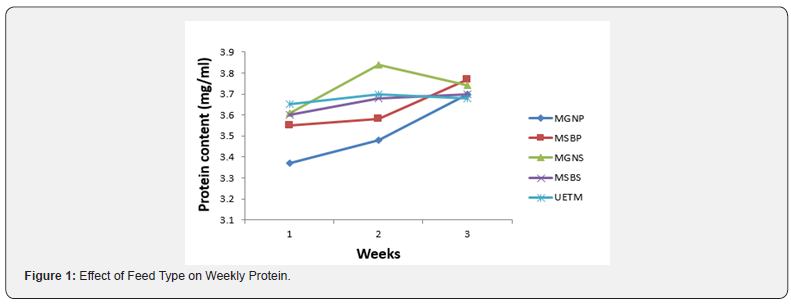



Fat content
Across feed type the highest average milk fat content (4.78%, se=0.52) was recorded in milk from cows fed on urea ensilage treated maize stover while the lowest (3.43%, se=0.52) was observed in milk from cows fed on maize stover that were improved using chopped groundnut stover (Table 3). Similarly, the differences were not significant (p>0.05) (Table 4). The variance estimate for milk fat for feeds was 3.960%.
Within legume type the milk fat was higher(4.75%±1.99) in milk from cows fed on maize stover blended with mineralized groundnut stover solution than that in milk from cows fed on maize stover improved with chopped groundnut stover (3.43%±1.99) (Table 3). A similar picture was observed in milk fat from cows fed on maize stover improved with the use of soybean (Table 3). There was a general decrease in milk fat with increase in days among all the samples from cows fed on the different feeds. The decline in fat content was more pronounced between week 1 and week 2. Between week 2 and week 3 the curve started levelling (Figure 2).
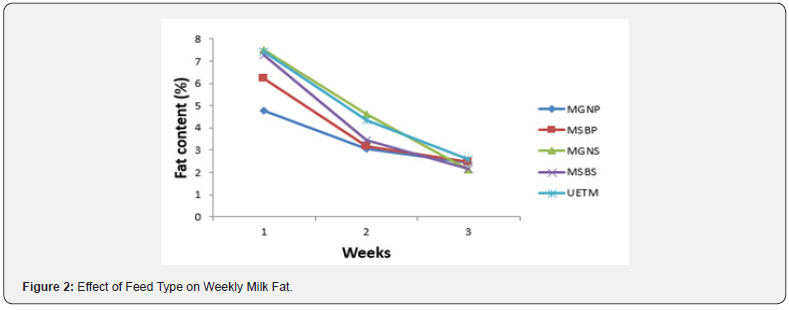

Lactose content
(Tables 5 & 6) show comparisons of levels of lactose content in the five (5) treatments used in the study. Milk from cows fed on urea ensilage treated maize stover reflected the highest (5.51 g, se=0.061) content of lactose, while milk from cows fed on maize stover blended with chopped groundnut stover was observed to contain the lowest (5.10 g, se=0.061) quantity of lactose. It was observed that the means for lactose content for the five (5) treatments did not differ significantly (p>0.05). When evaluated within each feed type results show a general increase in lactose content with period. Lactose content consistently increased from week 1 to week 3 in milk from cows fed urea and chopped legume stover based feeds. Lactose content in milk from cows fed on mineralized legume stover based feeds declined between week 2 and week 3 (Figure 3). The variance estimate for lactose content was 0.056 g.

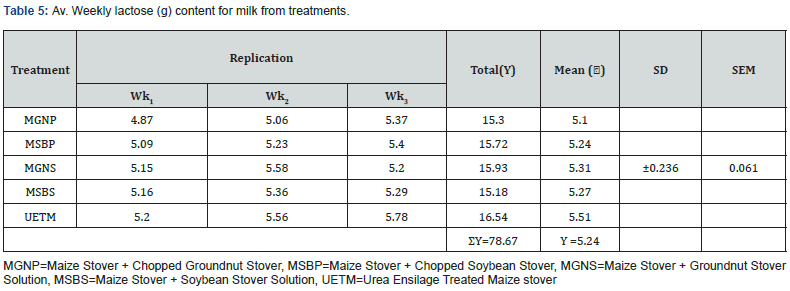

Solid-Not-Fat (SNF) content
Results of the study indicated higher (9.61 p/cwt, se=0.14) Solid-not-fat levels in milk from cows fed on maize stover improved by blending with mineralized groundnut stover solution. The study further showed that milk from cows fed on maize stover mixed with chopped groundnut stover had the lowest (8.88 p/ cwt, se=0.14) Solid-not-fat (Table 7). Milk from cows fed on the five feeds showed a similar trend in SNF content during the feeding period. There was a gradual increase in SNF content in milk between week 1 and 2, followed by a gradual decrease in SNF content in milk between weeks 2 and 3 (Figure 4). Levels among all the five (5) treatments did not differ significantly (p>0.05) (Table 8).
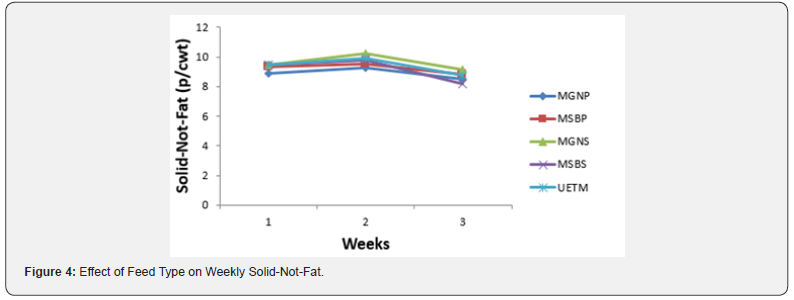


Milk Density

Results of the current study revealed numerical differences in density ranging from 32.65 sg, se=0.53 for milk from cows fed on urea ensilage treated maize stover to 30.42 sg, se=0.053 for milk from cows fed on maize stover blended with chopped groundnut stover (Table 9). Despite these differences there were no significant (p>0.05) differences among the effects of treatments (Table 10). Milk density from cows fed on the five feeds showed a similar trend over the feeding period. Milk samples collected between week 1 and week 2 reflected a gradual increase in density after which milk density in all the samples showed little or no change (Figure 5).

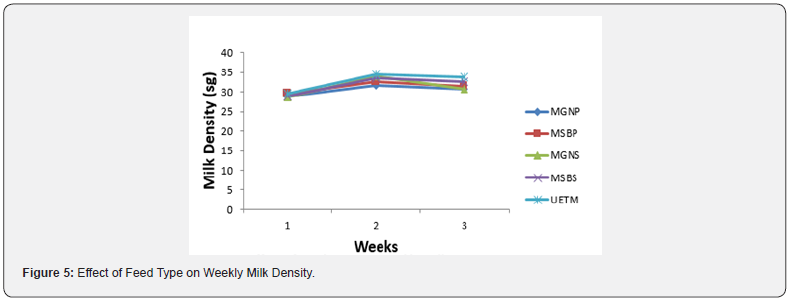
Milk Freezing Point
An evaluation of the effect of feed type on Freezing Point (PF) of milk showed lowest (59.95oC, se=0.42) in milk from cows fed on maize stover treated with chopped groundnut stover and highest (64.15oC, se=0.42) Freezing Point in milk from cows fed on maize stover treated with urea by urea ensilage. Generally Freezing point for milk from cows fed urea, chopped soybean and chopped groundnut stover increased with increase in lactation period (i.e from week 1 to week 3). Milk freezing point in milk samples from cows fed on mineralized legume stover based feeds (i.e mineralized soybean and groundnut stover) increased between week 1 and week 2 and showed a decline thereafter (Figure 6) (Tables 11 & 12).
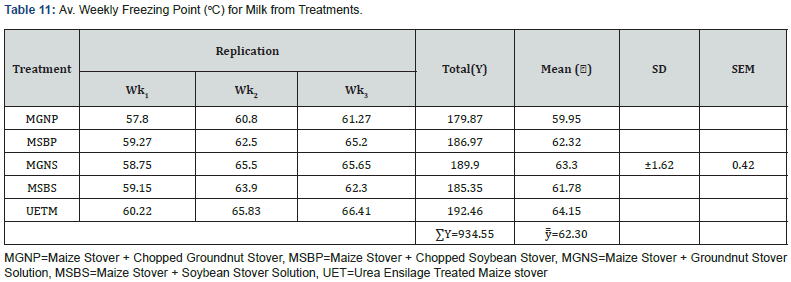

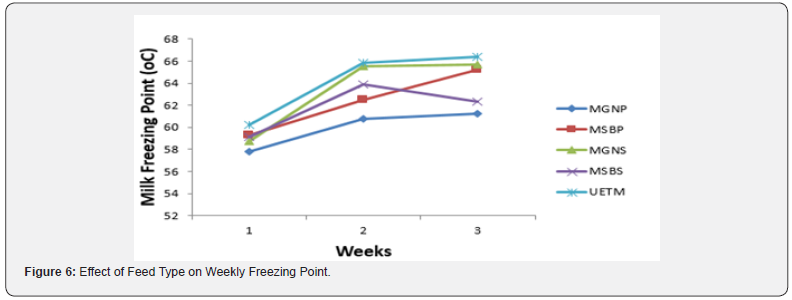
Discussion
Effect of legume type on milk quality
Milk quality differences recorded among the effect of treatments were certainly related to the diets’ nutrient contents, in particular the protein content which was higher in groundnutbased diets and UET and lower in soybean based diets (Table 1, Figures 1 & 2). We can also explain this difference by several factors such as the biological variations among experimental units. The overall mean values of fat and SNF 4.528 and 8.754 percent observed by [21], were in consonance with results of today’s study. Similarly, [22] reported variations in milk quality on the basis of type of legume forage used. Cows on Red Clover diets yielded milk with lower milk fat and protein contents than cows fed on grasses and other legumes.
Results of the current study are in agreement with those of [23], who reported previous studies in Thailand showing milk fat percentage levels for crossbred cattle ≥75% Holstein having milk fat values of 3.77%, with a protein content of 3.17 g/ml. This low level in fat content is a result of high temperatures and humid climate characteristic of tropical regions. This study used the Batoka crossbreed resulting from cross breeding of local cattle and the Holstein Friesian dairy breeds. This implies that the experimental units used in the current study had some percentage of Bos indicus influence which affects milk fat. Results of the study by [24], who used Sahiwal and Red Sindhi showed higher milk fat values (4.3-5.2% and 4.5-5.2%, respectively) than the values observed in today’s study.
In the current study it was observed that milk fat was the most variable component (4.24% ±1.99) not only among feed types but also over time (Feeding period) (Table 3, Figure 3). However, despite the observed numerical variations, levels of fat content did not differ significantly (p>0.05) among treatments or sources of nitrogen. Factors contributing to variations in milk composition include species, differences between individuals within strain and differences in conditions affecting individuals. On all milk components, milk fat is the most influenced by dietary manipulation. Most changes in milk composition due to dietary manipulation are related to changes in ruminal-acetatepropionate ratio. Among the notable factors that influence milk composition are plane of nutrition, forage to concentrate ratio, forage quality (e.g particle size), level and type of dietary fat.
Outcomes of this work agree with those of [25], who indicated that milk fat depression can be alleviated within 7 to 21 days by changing the diet. Milk protein changes may take 3 to 6 weeks or longer if the problem has been going on for a prolonged period. Protein and Lactose were observed to be the least variable (3.64 g/ml ±0.12, and 5.24 g ±0.24 respectively). This lower difference in protein and lactose among treatments is indicative of suitability of groundnut and soybean stover as possible alternatives to the use of conventional sources of Nitrogen in dairy rations.
When evaluated across legume type fat, protein, SNF, FP and lactose contents were numerically higher in milk from dairy cows fed on groundnut stover based diets. However, there were no significant (p>0.05) differences among the treatments. In contrast density was numerically higher in milk from cows fed on soybean stover based diets. Similarly, no significant (p>0.05) differences were observed among the treatments. These results may be due to the differences in nutritive value of the materials used to improve the quality of maize stover.
Effect of processing method on milk quality
The outcomes of the study have shown a general common trend in protein level, fat percentage, lactose level, SNF, Milk Density and Milk Freezing point (FP). When evaluated within feed type, milk components were higher in milk from cows fed on maize stover treated with mineralized legume stover solutions than in that in milk from cows fed on maize stover treated with chopped legume stover.
In an evaluation of milk components between feed types, the study has revealed that milk from cows fed on maize stover treated with chopped soybean stover was higher in almost all milk components than that from cows fed maize stover treated with chopped groundnut stover.
Conversely, milk components in milk from cows fed maize stover treated with mineralized groundnut stover solution were higher than milk components from cows fed on maize stover treated with mineralized soybean stover solution.
Conclusion
The study has revealed that milk protein, fat, lactose and solid-not-fat components were generally higher in milk from cows fed on maize stover improved using groundnut stover than milk from cows fed on soybean-based rations. When evaluated across processing method today’s study has indicated that milk from cows fed on maize stover improved with mineralized legume stover solution was superior in protein, fat, lactose and solid-notfat components than that from cows fed on maize stover improved with chopped legume stover. Results of the current study have indicated that milk composition is clearly influenced by diet, and period of lactation. This study has revealed differences in the effect of legume type on milk composition. Milk from cows fed on Urea based diet was superior in all milk components than that from both soybean and groundnut-based diets. In the current study it was observed that milk fat was the most variable component not only among feed types but also over the feeding period. Though milk components differed numerically these differences were not significant (p>0.05). Results of this study indicate that soybean and groundnut stover can be used interchangeably without adversely affecting milk composition. Smallholder farmers and animal nutritionists can positively influence the composition (nutritive value) of milk by improving the quality of maize stover with cheap and locally available legume stover in formulating dairy rations. Additionally, the study has shown that improving the quality of maize stover using mineralized legume solutions is more effective in altering the milk quality on smallholder dairy farms. Finally, the potential of other legume stover other than those of groundnut and soybean should be evaluated.
Acknowledgment
The authors of this article are thankful to Batoka Livestock Centre for availing their facilities during the research. We are grateful to Professor Pandey of the veterinary school at the University of Zambia for facilitating the laboratory sample analysis. Authors are grateful to smallholder dairy farmers who provided important information during the trials.
Conflict of Interest
The authors declare that they have no competing interests. There is no conflict of interest regarding the publication of this article.
References
- WHO/FAO (2003) Global and Regional Food Consumption Patterns and Trends. Nutrition Reviews Rome, Italy, 137-163.
- Aregheore EA (2010) Country Pasture/Forage Resource Profiles: Zambia II. Lusaka, Zambia Journal of Geographic Research 2(1): 98-111.
- Ochetim S (1995) Pig Farming in Zambia. Shawa IG (Ed). Zambia Educational Publishing House. Lusaka, pp. 65-94.
- Speedy AW (2002) Global Production and Consumption of Animal Source Foods. Proceedings of Animal Source Foods and Nutrition in Developing Countries. J Nutr 133(11): 4048S–4053S.
- Rhone AJ (2008) Factors Affecting Milk Fat, Milk Quality and Economic Performance of Dairy Farms in the Central Region of Thailand. PhD Dissertation, University of Florida, Florida, USA, 26-46.
- Palmquist DL, Bealulieu AE (1993) Feed Animal Factors Influencing Milk Fat Composition. Journal of Dairy Science 76(6): 1753-1771.
- Looper M (2012) Factors Affecting Milk Composition of Lactating Cows. Little Rock, Ark Cooperative Extension Service, University of Arkansas, U.S. Dept. of Agriculture, and county governments cooperating, USA 96-122.
- Ministry of Agriculture and Cooperatives (MOAC) (2005). Thailand’s Dairy Industry Modernization Mannual. Ministry of Agriculture and Cooperatives, Bangkok, Thailand, 15-38.
- Midou A, Kibon A, Morupa SM, Augustine C (2010)Influence of Season on Milk Yield and Milk Composition of Red Soko Goats in Mubi Area of Adamawa State, Nigeria: International Journal of Dairy Science 5(3): 135-141.
- Nyamushamba GB, Chikwanda D, Matondi GHM, Marandure T, Mamutse J, (2014) The Effect of Non-genetic Factors on Milk Yield and Composition of Red Dane Cattle in Zimbabwe. Livestock Research for Rural Development 26(5): 125-132.
- Suthisak R, Vijchulata P, Chairatanayuth P, Sintuvanich S, Santisopasri V (2014) Influence of Feeding Management and Seasons on Yield and Composition of Milk Produced from Friesian Crossbred Cows Raised Under Hot and Humid Environment in Central Thailand. Journal of animal Science and Technology49(5): 410-430.
- Jonkus D, Paura L, Kairisha D (2004) Analysis of Daily Milk Productivity Change in Dairy Cowsveterinarija IR Zootechnika T 27(49): 29-52.
- Najib, Eng KP (2013) Pasture and Fodder Establishment and Management for Smallholder Dairy Production. Journal of Pasture and fodder management 67(23): 213-221.
- Kitaeg N, Kittyan K, Insk N, Abanto OD and SongGu H(2009) Seasonal and Regional Effects on Milk Composition of Dairy Cows in South Korea. Journal of animal Science and Technology 51(6): 537-542.
- Pavel ER, Gavan C (2011) Seasonal and Milking to Milking Variations in Cow Milk Fat, Protein and Somatic Cell Counts. Notulae Scientia Biologicae 3(2): 20-23.
- Ministry of Agriculture and Livestock (2013)Ministry of Agriculture and Livestock Report to Paliament, Lusaka, Zambia, pp. 35-51.
- BLP88 (1987)Linear Programming with Bounded Variables for IBM PC. User Manual. Eastern Software Products, Alexandria, Virginia, USA, pp. 93-111
- National Research Council (NRC) (2001) Nutrient Requirements of Dairy Cattle, 7th Revised Edition. National Academy Press, Washington DC, USA, pp. 200-209
- Davies DT, Holt C, Christie WW(1983)The Composition of Milk. Ch. 5 in Biochemistry of Lactation, Mepham TM (Edtn). Amsterdam, Holland, 95-105
- Jenness R(1985) Biochemical and Nutritional Aspects of Milk and Colostrum. Ch. 5 in Lactation, Larson N, (Ed). Ames: Iowa State University Press, USA, 160-187.
- Sharma RB, Kumar M, Pathak V(2001)Effect of Different Seasons on Cross-Bred Cow Milk Composition and Paneer Yield in Sub-Himalayan Region. Asian-Australasian Journal of Animal Sciences 15(4):528-530.
- Steinshamn H (2010) Effect of Forage Legumes on Feed Intake, Milk Production and Milk Quality-A Review. Biofork, Norwegian Institute for Agricultural and Environmental Research. Animal Science papers and reports 28(3): 195-206.
- Garcia O, Hemme T, Rojanasthien S,Youggad J(2005)The Economics of Milk Production in Chiang Mai, Thailand, with Particular Emphasis on Small-scale Producers, Working Paper, Pro-poor Livestock Initiative. Food and Agriculture Organization of the United Nations, Rome, pp. 50.
- Taneja VK (1999) Dairy Breeds and Selection, Ch.5 in Smallholder Dairying in the Tropics International Livestock Research Institute, Nairobi, Kenya, 154-190.
- Heinrichs J, Jones MC, Bailey K (2016)Milk Components: Understanding Milk Fat and Milk Variation in Your Dairy Herd. College of Agricultural Sciences. Pennysylvania State University. 323 Agricultural Administration. Building University Park, PA 16802, USA, 85-99.






























